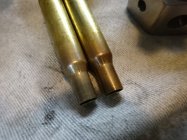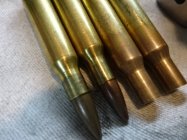I had a similar project forming 17-222 cases from .223/5.56 cases. I tested both Imperial Sizing Wax and Hornady OneShot... either one works. I prefer Imperial Sizing Wax for forming steps that are high pressure (compressing cases to form small diameter necks), but you are just bumping back a shoulder so either should work.
When using Range Brass, be selective and do QC on the front-end to ensure a good end-product. To reduce amount of rejects don't use any cases that have deep nicks at neck/shoulder area (common case damage from lugs on AR15). These become splits/crevices in the newly-formed shoulder/neck.
1) Shoulder on .223 donor case becomes the newly-formed neck on .222 case.
2 Upper 1/8" of body on .223 donor case becomes the newly-formed shoulder on the 222 case.
You want the brass really clean (steel pin wet tumbling). Before starting the case forming, I resizing the .223/5.56 cases through .223 Full Length Sizing Die and then annealing the cases. Annealing makes a huge difference in the ease and consistency out final formed case. You want to anneal at least 1/4" down case body so that you capture the case wall that will become the shoulder on the formed .222 case. After annealing it helps to polish the outside of the case to remove metal scale/oxidation that results from the heat. Use a 3M pad (red or grey colored). This will protect your dies from getting scratched up and also reduce friction during the forming process.
I initially started my .222 case forming process using a set of 221 Forming Dies (221 FB Form and 221 Trim Die). These dies reduce the diameter of the case body in 2 steps to the desired neck diameter. No splits or any issues....really easy. Then I tried just using a Redding 222 Bushing FL Die (removed the internal parts). With consistent pressure on the ram it worked in one pass, clean and easy.
I didn't experience any wrinkling as long as I didn't use excess amount of lubricant. Also, just before the ram stroke has bottoms out, back off the ram just a fraction to let any trapped/pressurized air to escape, and then finish the last portion of the case's resizing stroke.
Good Luck
When using Range Brass, be selective and do QC on the front-end to ensure a good end-product. To reduce amount of rejects don't use any cases that have deep nicks at neck/shoulder area (common case damage from lugs on AR15). These become splits/crevices in the newly-formed shoulder/neck.
1) Shoulder on .223 donor case becomes the newly-formed neck on .222 case.
2 Upper 1/8" of body on .223 donor case becomes the newly-formed shoulder on the 222 case.
You want the brass really clean (steel pin wet tumbling). Before starting the case forming, I resizing the .223/5.56 cases through .223 Full Length Sizing Die and then annealing the cases. Annealing makes a huge difference in the ease and consistency out final formed case. You want to anneal at least 1/4" down case body so that you capture the case wall that will become the shoulder on the formed .222 case. After annealing it helps to polish the outside of the case to remove metal scale/oxidation that results from the heat. Use a 3M pad (red or grey colored). This will protect your dies from getting scratched up and also reduce friction during the forming process.
I initially started my .222 case forming process using a set of 221 Forming Dies (221 FB Form and 221 Trim Die). These dies reduce the diameter of the case body in 2 steps to the desired neck diameter. No splits or any issues....really easy. Then I tried just using a Redding 222 Bushing FL Die (removed the internal parts). With consistent pressure on the ram it worked in one pass, clean and easy.
I didn't experience any wrinkling as long as I didn't use excess amount of lubricant. Also, just before the ram stroke has bottoms out, back off the ram just a fraction to let any trapped/pressurized air to escape, and then finish the last portion of the case's resizing stroke.
Good Luck













